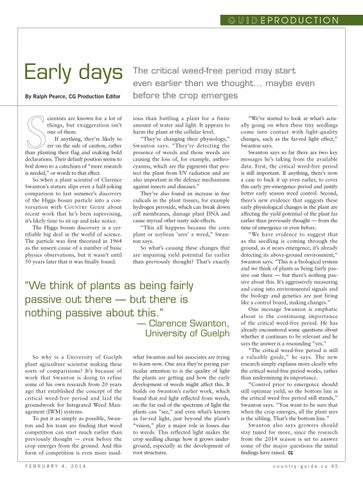production
Early days By Ralph Pearce, CG Production Editor
The critical weed-free period may start even earlier than we thought... maybe even before the crop emerges
cientists are known for a lot of things, but exaggeration isn’t one of them. If anything, they’re likely to err on the side of caution, rather than planting their flag and making bold declarations. Their default position seems to boil down to a catechism of “more research is needed,” or words to that effect. So when a plant scientist of Clarence Swanton’s stature slips even a half-joking comparison to last summer’s discovery of the Higgs bosun particle into a conversation with C ountry G uide about recent work that he’s been supervising, it’s likely time to sit up and take notice. The Higgs bosun discovery is a certifiable big deal in the world of science. The particle was first theorized in 1964 as the unseen cause of a number of basic physics observations, but it wasn’t until 50 years later that it was finally found.
ious than battling a plant for a finite amount of water and light. It appears to harm the plant at the cellular level. “They’re changing their physiology,” Swanton says. “They’re detecting the presence of weeds and those weeds are causing the loss of, for example, anthrocyanins, which are the pigments that protect the plant from UV radiation and are also important in the defence mechanisms against insects and diseases.” They’ve also found an increase in free radicals in the plant tissues, for example hydrogen peroxide, which can break down cell membranes, damage plant DNA and cause myriad other nasty side-effects. “This all happens because the corn plant or soybean ‘sees’ a weed,” Swanton says. So what’s causing these changes that are impairing yield potential far earlier than previously thought? That’s exactly
“We think of plants as being fairly passive out there — but there is nothing passive about this.”
— Clarence Swanton, University of Guelph
So why is a University of Guelph plant agriculture scieintist making these sorts of comparisions? It’s because of work that Swanton is doing to refine some of his own research from 20 years ago that established the concept of the critical weed-free period and laid the groundwork for Integrated Weed Management (IWM) systems. To put it as simply as possible, Swanton and his team are finding that weed competition can start much earlier than previously thought — even before the crop emerges from the ground. And this form of competition is even more insidFEBRUARY 4, 2014
what Swanton and his associates are trying to learn now. One area they’re paying particular attention to is the quality of light the plants are getting and how the early development of weeds might affect this. It builds on Swanton’s earlier work, which found that red light reflected from weeds, on the far end of the spectrum of light the plants can “see,” and even what’s known as far-red light, just beyond the plant’s “vision,” play a major role in losses due to weeds. This reflected light makes the crop seedling change how it grows underground, especially in the development of root structures.
“We’ve started to look at what’s actually going on when these tiny seedlings come into contact with light-quality changes, such as the far-red light effect,” Swanton says. Swanton says so far there are two key messages he’s taking from the available data. First, the critical weed-free period is still important. If anything, there’s now a case to back it up even earlier, to cover this early pre-emergence period and justify better early season weed control. Second, there’s new evidence that suggests these early physiological changes in the plant are affecting the yield potential of the plant far earlier than previously thought — from the time of emergence or even before. “We have evidence to suggest that as the seedling is coming through the ground, as it nears emergence, it’s already detecting its above-ground environment,” Swanton says. “This is a biological system and we think of plants as being fairly passive out there — but there’s nothing passive about this. It’s aggressively measuring and cuing into environmental signals and the biology and genetics are just firing like a control board, making changes.” One message Swanton is emphatic about is the continuing importance of the critical weed-free period. He has already encountered some questions about whether it continues to be relevant and he says the answer is a resounding “yes.” “The critical weed-free period is still a valuable guide,” he says. The new research simply explains more clearly why the critical weed-free period works, rather than undermining its importance. “Control prior to emergence should still optimize yield, so the bottom line is the critical weed free period still stands,” Swanton says. “You want to be sure that when the crop emerges, all the plant sees is the sibling. That’s the bottom line.” Swanton also says growers should stay tuned for more, since the research from the 2014 season is set to answer some of the major questions the initial findings have raised. CG country-guide.ca 45
